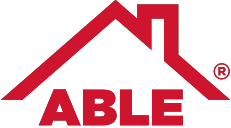All roofing systems are not created equal. Some protect against outside elements, including fire, better than others. A roof can ignite due to a number of circumstances, including a brush fire, chimney sparks, and airborne brands ejected from a neighboring building. Therefore, fire resistance is an important safety consideration. It is also why the Federal Housing Administration requires that roofing materials conform to certain standards.
Know Your ABC’s: Pay Attention to Fire Ratings
In order to determine which Columbus roofing system fares the best against fiery flames, you should pay attention to fire ratings. “Class A” is the highest rating, providing the best resistance to fire. Some common “Class A” roof coverings are fiberglass asphalt composition shingles, concrete or clay roof tiles, authentic stone slate roofs and metal roofs. A “Class B” fire-resistance rating indicates that Columbus roofing materials are able to withstand moderate exposure to fire originating from sources outside the building. A “Class C” rating indicates it can withstand only light exposure to fire. The worst possible rating is “unrated.” An example of a material from this category is an untreated wood shake roof.
How Fire Ratings are Determined
Fire ratings for your Columbus roofing system are determined by a standard fire test, which evaluates three specific performance criteria: flame penetration through the roof covering into the attic space, flame spread over the surface of the roof covering, and the propensity for the roof covering to become dislodged and generate embers.
During this test, the Columbus roofing material must not blow or fall off the deck as flaming or glowing brands. It also must not break, slide, crack or warp to expose the roof deck. It must not allow the roof deck to fall away as glowing particles. Lastly, it must not allow sustained flaming of the underside of the roof deck. These factors will all determine which rating the roof will be assigned.
Improving the Fire Rating of Your Columbus Roofing System
If you find that you need to improve your Columbus roofing system’s fire rating, you can install an underlying material, or special installation technique. Fire ratings for roof coverings that rely on additional material are called “by assembly fire ratings” as opposed to “stand-alone fire ratings.” An example of a by assembly fire rating is fire-retardant treated wooden shakes, which have a stand-alone Class B rating. However, they can meet the requirements for a Class A roof if you add a specific underlying material to them, the most common of which is a Type 72 roll roofing material and a panelized gypsum product called DensDeck.
An aluminum or metal roof is another example of a by assembly roof covering. It is by assembly because, while it is considered a non-combustible material due to its low melting point, it still requires an additional underlying material to achieve the Class A fire rating.
Keep in mind that the required roof rating for your Columbus roofing system depends on the fire hazard rating where you live. To obtain this information, contact your local fire department, building regulations department, or Columbus roofing contractor. And remember; only you can prevent a roof fire.
Ask Columbus Roofing Contractor, Able Roofing, to Inspect Your Roof’s Fire Rating
Able Roofing Columbus is the largest residential roofing contractor in Central Ohio. Each Columbus roofing contractor is highly skilled in all areas of roofing, siding, windows, masonry, and more. Our specialties include ice dam repair, roof leak repair service, general roof repairs, preventive roof maintenance, roof inspection, roof replacement, roof installation, and roof restoration. Call us at 1-614-444-ROOF to schedule a free estimate or click to learn more about our roofing services.







